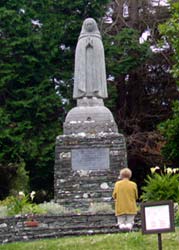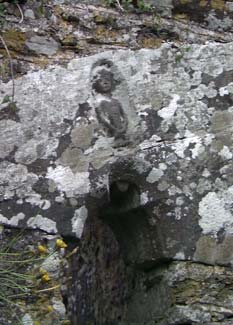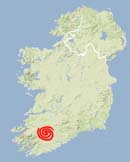03 May Ballyvourney Monastic Site
“A good specimen of a connecting link between the pagan keel with its old-world ceremonies and Christian rites is afforded by observances which were formerly practiced at Ballyvourney, Co. Cork, at a keel or low carn, composed of stones and earth, evidently an ancient pagan cemetery. On the summit of the mound lay a bullaun, with a circular cavity or basin, overshadowed with low-growing bushes on which hung rags of various colours, votive offerings of pilgrims who were accustomed to encircle the mound upon their knees in the course of the sun. Persons afflicted with bodily ailments resorted hither esteeming earth from the mound and rain water from the bullaun, to be specifics for their complaints…”
W.G. Wood-Martin, Traces of the Elder Faiths of Ireland, 1902 1
Drag within the image to explore the Ballyvourney Monastic Site in virtual reality.
An interactive map will appear when you click the button to enter full-screen mode.
Touch here for the mobile version.
When “a committee of the leading men of Ballyvourney” raised the funds in 1950 to commission a statue of St. Gobnait near the traditional site of her sixth-century convent, their work was interrupted after significant archaeological objects were discovered during the site preparation. The small circular early medieval enclosure called St. Gobnait’s House was found to sit upon the remains of some 137 forges, perhaps dating to as early as the first few centuries CE (see illustrations in gallery below).2 Thus long before St. Gobnait’s time at Ballyvourney, the landscape would have been filled with the smoke and the din of an early industrial site where objects of iron and bronze were manufactured.
St. Gobnait’s House is the second station on the turas (a journey, or pattern) the faithful still perform today. But the next two stations, a bullaun stone, its hollow often containing rainwater, and a large slab, sit on a prehistoric mound that likely contained a megalithic burial cist at its center. This structure, now known as St. Gobnait’s Grave, therefore may be thousands of years older than the time of this saintly woman of the sixth century. With this ancient patrimony, can it be merely a coincidence that the Celtic god of fire and metalworking, Goibniu, has a name so similar to that of Gobnait, the patron saint of beekeepers?3
These three stations of the turas listed above, as well as most of its other seven locations,4 may be seen in the virtual-reality tour of the site, top left. Some of the scenes have hotspots linking to more detailed close-up views. Click on the “full-screen” button to use the interactive map. The VR tour begins in front of St. Gobnait’s House, the excavated and restored circular hut, with an internal diameter of 6 m (20 ft). This panorama also includes the statue of the saint standing upon her beehive. This is the first station of the turas, and St. Gobnait’s Holy Well is also within the scene (look down).5 Hotspots will take you across the road to the small mound reputed to be the saint’s grave and then into the remains of the medieval church, built atop the foundations of an earlier structure. This church has likely been in ruins since its roof was dismantled in 1649 to make it seem derelict as Cromwell’s forces approached.6 A final link takes you down the hillside to St. Abbán’s Holy Well,7 in a sylvan grotto alive with the colorful tokens of hope and devotion left by today’s pilgrims.
St. Gobnait
The excavator of St. Gobnait’s House, Professor Michael O’Kelly, remarked in 1952 on the persistent devotion to the saint:
“Local belief that the saint lived in the house remains, therefore, undisturbed and the site continues to be held in very high esteem not only by the people of Ballyvourney, but also by people all over the south of Ireland. Throughout the period of the excavation not a day passed but numbers of pilgrims, young and old, male and female, came to make the long and difficult ’round’ and it was most edifying to observe the fervour and devotion with which they prayed, ignoring us and our work and kneeling unselfconsciously at each stopping point on the ‘round.'” 8
St. Gobnait is also revered in the Aran Islands, where she fled to escape persecution on the mainland. An angel visited her and said that she should seek a place where she would see nine white deer grazing. Gobnait wandered about the south of Ireland, searching throughout Waterford, Cork and Kerry. She finally found her magical herd of deer at Ballyvourney, where she established her church, a kilometer (.6 mi) south of the modern town. On land given to her by St. Abbán she began a community for religious women and became its first abbess. She was known especially for her skills as a healer, even using her powers to keep the plague from entering Ballyvourney. Her connection with bees may have derived from the understanding in her time of the curative powers of honey.
A remarkable tradition, which depicts St. Gobnate as the patron of bees [concerns] a chief, on the morning of a battle, perceiving with dismay the inferiority in number of his followers compared with those of his adversaries, prayed to St. Gobnate for assistance. The good saint granted his request by turning a swarm of bees, close at hand, into armed soldiers, who issued from the hive in military array, ranged themselves in ranks, and followed their leader to victory. After the battle the victorious chief visited the spot from whence he had received such miraculous assistance, and found the rush-formed hive metamorphosed into a brass utensil.9
While the historical Gobnait may be subsumed in her miracles and mythology, such was her devotion among the people that Pope Clement VIII in 1601 granted a special indulgence in her name.10 Today, while the only active congregation on the site is in its 19th-century Protestant church, a steady stream of Catholic pilgrims visits the ruins to evoke the saintly intervention of the long-dead Abbess Gobnait.
Her feast day is the 11th of February.11 It is still honored by the faithful, as there was a crowd of 120 on that date in 2011, making their rounds (always clockwise) at each of the ten different stations.12 In past centuries there was also a turas here on Whit Sunday, but it developed a reputation for pursuits more pleasurable than pious, and was suppressed by the authorities.13
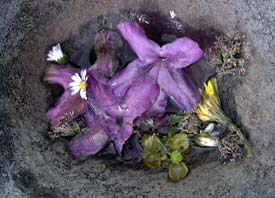
The continued devotion to St. Gobnait’s is evident by the personal mementos left at the scene, including these blooms left in her bullaun stone.
During the turas, pilgrims use sharp stones to re-trace the rough crosses inscribed into some of the slabs, refreshing these timeworn markings with evidence of their own visits. At either of the two wells the faithful might sip from one of the cups provided, and then fill a bottle of water to bring home. At every visit to one of the ten stations the pilgrim performs seven recitations each the “Our Father,” the “Holy Mary,” and the “Glory Be” prayers. Most of the stations are visited several times during the ritual procession.14 For a further discussion of the turas in Ireland, see our page on Gleann Cholm Cille.
Ballyvourney was in the 19th century also famous as a school for the training of bacachs, an organized community of beggars who traveled about the country practicing their trade at both religious and secular fairs.15
Today on St. Gobnait’s feast day in Ballyvourney, and on Whit Sunday, the parish priest retrieves a 13th-century oaken statue, said to be an effigy of the saint (or the Madonna), and exhibits it on the altar during the Mass. This small figure, only 70 cm (27.5 in) long, has a deteriorated face with only a single eye remaining (see photo in gallery). But this eye is, as one author observed, “of such character and virility of expression that one could well understand its reputed power.”16 Many of those in attendance approach the statue and hold a length of blue ribbon against it (the Tomhas Ghobnatan, or Gobnait’s Measure.) They each take their ribbons with them to grant a blessing on their homes. In 1727 a crusading Protestant writer described the statue being set upon on a wall of the ruined church, while pilgrims walked around it three times.
And they conclude with kissing the Idol, and making an Offering to it every one according to their Ability…The image is kept by one of the Family of the O Herlehy’s, and when any one is sick of the Small Pox, they send for it, Sacrifice a Sheep to it, and wrap the Skin about the sick Person, and the Family eat the Sheep. But this Idol hath now much lost its Reputation, because two of the O Herlihys died lately of the Small Pox.17
The Sheela-na-gig
There is one other statue of the saint invoked during the Ballyvourney turas. At station #7, inside the church ruins, the pilgrim would traditionally stand on the sill of the south window, extend his arm out through the opening, then reach up and rub a much eroded statue of a woman set into a niche above the window.18 The figure may be seen via a hotspot in the VR tour, and also in the photograph, below right. While the faithful consider the statue to be an image of St. Gobnait, it is also thought to be one of the anatomically explicit sheela-na-gig sculptures found throughout the country that were often invoked in folk practices.19
When the workers of the Ordnance Survey recorded the first discovery of a sheela-na-gig in Co. Tipperary in 1840, Thomas O’Connor described it with some indignation as
A shockingly crude, naked female with splayed legs and fingers holding open a gaping vulva. Two odd breasts, one with two nipples, a triangular Celtic head and a pipe-stem neck … whose attitude and expression conspire to impress the grossest idea of immorality and licentiousness.20
The Ballyvourney sheela-na-gig differs from most of the others as she is standing rather than crouching. Furthermore, her head is not rendered in a grotesque manner, nor do her hands seem to be exposing her genitals as depicted in most of the sheela-na-gig figures.21
Although few now believe that these stone figures pre-date the medieval structures on which they are usually found,22 there is much dispute regarding the origin and meanings of these statues. Often startling in its provocative pose, the sheela-na-gig has been explained in different generations in ways that changed with the zeitgeist. Some have found in the sculptures powerful iconographic links to the mytical hag-goddesses of Celtic tradition, such as the Cailleach Bhéara (Hag of Beare). Most scholars today understand the sheela-na-gig as an Irish form of the Continental grotesque figure dating from the Romanesque or Medieval era.
However for Maureen Concannon, author of The Sacred Whore: Sheela, Goddess of the Celts (2004), the sheela-na-gig is a pagan symbol of “the Generative Mother:”
“Study reveals that the origins of the Sheela symbol lie not in France, England or Scotland, but in ancient pre-Celtic Ireland, and have been incorporated into subsequent cultures and religions on this island. The source of these carvings can be traced back to a goddess religion practised before patriarchal religions surfaced. Sheela carvings are symbols of the Divine Hag of the Celts, the source of life, death and regeneration.” 23
Most other writers are confident that the sheela-na-gig is but one example of the genre of montrous figures consistent with Continental examples, which include grotesque shapes of all sorts, perhaps serving to illustrate for illiterate Christian peasants moral lessons depicting the extremes of human behavior. The figures might have been intended to have an apotropaic effect, to avert evil (see Charles Eisen illustration in gallery). In The Witch on the Wall (1977), Jørgen Anderson wrote:
She belongs with the alluring shapes and the monster combats in the sub-world of Romanesque art, where an erotic colouring of the troubles of mankind are always a possibility.24
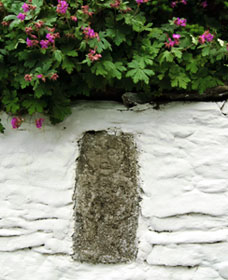
When a farmhouse gatepost was reconstructed in Balgeeth, Co. Meath, a hidden sheela-na-gig was discovered. The slab was then mounted in the wall with its figure displayed.
Deployed often as corbel figures by the Romanesque architect, similar “exhibitionist” designs might include, according to Barbara Freitag: musicians, jugglers, thorn-pullers, mermaids, anus-displayers, penis-swallowers, man-eating monsters, grotesquely copulating couples, “as well as almost any combination of the foregoing.”25
In their 1986 book Images of Lust, authors Anthony Weir and James Jerman conclude that the sheela-na-gigs, while ultimately acquiring some significance in folk belief, were originally intended to serve as morality lessons in stone. They conclude that the Irish and English examples are highly influenced, or actually modeled on, similar figures in France. They also point out that, outside of Ireland, there are more male than female Romanesque exhibitionist figures found. The authors included in their text a succinct but illuminating compendium of the range of published opinions regarding the sheela-na-gig, including one from the 1967 Shell Guide to Ireland (“Sheela-na-gig: an obscene female figure of uncertain significance…”) and one by Margaret Murray from an journal article in 1923 (“Probably the remains of a fertility cult…”).26 More on this subject by Anthony Weir may be seen here.
The etymology of the term sheela-na-gig is as clouded as the provenance of the figures themselves. In the middle of the 19th century, Thomas Wright translated the name as “Julian the Giddy,” perhaps indicating a person overly attracted to the opposite sex.27 Another Irish rendition of the name, Sighle na gCíoch, can be translated as “the old hag of the breasts.” or perhaps “…on her hunkers [squatting].” But sheela-na-gig may be a term with no roots in the populace, as it is not found in any Old Irish source. “Gig” is not a word from the Irish language, though it may be a cognate with “jig,” and thus may refer to a “dancing woman.” There is some evidence that the term was also used to describe women of ill repute, or even old hags28. It is also possible that that the term sheela-na-gig is simply an invention of the early antiquarians, although variations of the name were noted from rural sources in three different counties in the early 1840s.29
Whatever its origin and the intent of its sculptor, the sheela-na-gig today has taken on a spiritual significance for some women who may seek out these stone figures when wishing a tangible communion with the “Great Goddess.” For these spiritual seekers, the sheela-na-gig may represent the powers of the earth mother or the wonders of fertility and childbirth.30 It may be that the books and websites (see below) devoted to discussions of sheela-na-gigs represent an unmet need among some women to “redress the lack of a feminine deity.”
“Sheelas display all the characteristics of women most feared, reviled and rejected by society because they portray characteristics that make a woman independent, strong and powerful. Physical beauty and sexual allure are insignificant when a woman is giving birth, expressing her wildness, her fearlessness, or dealing with death. She does not think of beauty – the issues are much too profound…. There is a deep need for a return to the feminine – a symbol of the ultimate power of creativity to balance that of destruction – to teach respect to the arrogant and give hope to the downtrodden. Sheela is a symbol of that much-needed feminine deity—the powerful Dark goddess of transformation and renewal.” 31
From the Ballyvourney Monastic Site, where (to some) the visage of an ancient pagan goddess of fertility and sovereignty peers down upon devout Christians celebrating a sixth-century holy woman, it is a four-hour drive across Ireland to the Co. Meath townland of Balgeeth, close to the Fourknocks Passage Tomb and to the Hill of Tara, where another Sheela may be found. At a farmhouse there in 1981, a old masonry gate pillar was being reconstructed in order to widen the driveway. Among the filling stones inside the dismantled wall was one obviously placed there to conceal it from view: a previously unknown sheela-na-gig.32 The 54-cm (21-in) tall exhibitionist figure is now proudly displayed on a courtyard wall (see photo above left). The young couple now living there maintain the stone, the farmwife wiping it down from time to time to allow its details to be seen. Not long after moving to the farm, although there was no record of multiple births in her family, she became pregnant with triplets. When we visited the site in 2010, the three youngsters, then about ten years old, eagerly assisted in our photography. Their mother, reluctant to chance another trio of infants, kept her distance.
“We look up at her
hunkered into her angle
under the eaves.She bears the whole stone burden
on the small of her back and shoulders
and pinioned elbows,the astute mouth, the gripping fingers
saying push, push hard,
push harder.”
excerpt from “Sheelagh na Gig at Kilpeck,” by Seamus Heaney, 1985 33
Click here to see all the notes from this page.
Ballyvourney Monastic Site, Co. Cork
Nearest Town: Ballyvourney
Townland: Ballyvourney
Latitude: 51° 56′ 17.7″ N
Longitude: 9° 10′ 0.5″ W
External Links:

